Standoff The history of creating 5,56-mm cartridges
Back in 1945, work was begun in the United States to create a new single 7,62-mm cartridge. As a prototype of such a cartridge was selected 7,62-mm rifle-machine-gun cartridge T 65 company Winchester. In 1954, it was standardized in the North Alliance and was named NATO 7,62-mm NATO cartridge (7,62 x51 mm). This cartridge had a bullet of good aerodynamic shape, the charge of high-capacity spherical granulation, reduced weight and dimensions, and in its ballistic capabilities was somewhat superior to the Soviet 7,62-mm rifle-and-machine-gun cartridge. 1908 of the year. It was intended for shooting as a group weapons - machine guns, and from individual weapons - automatic rifles. The presence of a single cartridge had, according to the idea of the American military leaders, a number of advantages compared with the Soviet dual system:
- the high power of the NATO 7,62-mm patron as compared with the Soviet 7,62-mm “intermediate” cartridge. The XXUMX of the year assumed a greater effective range of automatic rifles compared to the AK assault rifle;
- NATO maintained two main models of small arms (a single machine gun and an automatic rifle) instead of three models in the Warsaw Pact countries — an easel (single) machine gun for a rifle cartridge and an automatic rifle and a machine gun for the cartridge XXNX of the year;
- thanks to the rearmament of the new patron of the NATO bloc, they got rid of a variety of small arms of various calibers and structures that have survived since World War II. For example, in the US Army, two new weapons replaced seven old models;
- Finally, a single cartridge allowed to increase mobilization readiness, simplify production and supply, operation and repair of weapons, facilitate and accelerate the training of soldiers.
At the same time, by the middle of the 1950-s, it was becoming more and more obvious to the US military that the new 7,62-mm NATO cartridge could not meet all the needs of the armed forces and ensure the possibility of accurate automatic fire from small arms. Weapons for this cartridge had a significant return, ammunition weighed quite a lot, which limited the ability of units to conduct dense fire. American automatic rifles M 14, adopted in 1957, under the new 7,62 x51 single rifle and machine-gun cartridge proved to be ineffective weapons because of the excessively large dispersion of shots with automatic shooting. Neither the various weapons schemes, nor the reduction of the initial bullet speed to 10% to reduce the recoil momentum, nor the development and adoption of the US Army in addition to the 7,62 x51 dual-cartridge rifle cartridge M 198 helped to improve the situation. As a result, automatic rifles for 7,62-mm HATO cartridge were converted into self-loading, which deprived them of one of the main advantages of modern individual weapons - high fire density with sufficiently high probability of hitting the target. In this regard, the command of the US armed forces was forced to make a decision to transfer the small arms system to a smaller caliber cartridge - 5,56-mm (nominally denoted by the American system .22, .221, .222, .223 or .224, but in fact, bullet diameter is the same for all the above designations).
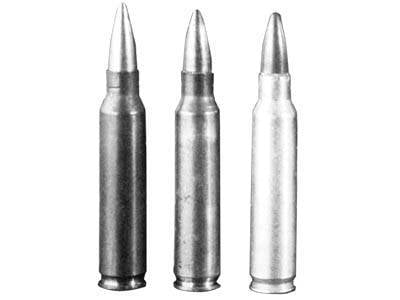 5,56х45 rifle cartridges .222 Remington (from left to right): .222 Remington with a bullet "type B" manufactured by Frankford Arsenal; .222 Remington Special with a “type A” bullet manufactured by Remington Arms; 5,56-mm cartridge 193 M made by the Belgian company FN
5,56х45 rifle cartridges .222 Remington (from left to right): .222 Remington with a bullet "type B" manufactured by Frankford Arsenal; .222 Remington Special with a “type A” bullet manufactured by Remington Arms; 5,56-mm cartridge 193 M made by the Belgian company FNThe problem of creating a low-impulse cartridge in the West was recognized long before the appearance of the standard 5,56 caliber mm cartridge. The first studies in this area were conducted during the First World War. The development of these works were presented to the promising models of small arms "Operational requirements for handguns", developed in 1952 year by the research department of combat operations at the University of J. Hopkins as a result of analyzing the experience of combat use of small arms in the Second World War and the Korean War. These requirements stated that:
1. to compensate for shooting errors, it is necessary to increase the fire density at a distance of up to 400 yards (365 m);
2. the most effective and economical when shooting at such a range is not a heavy 7,62-mm bullet with a small initial speed, but a very light high-speed bullet;
3. each hitting the target must be fatal, since the vulnerable organs of a person in the standing position make up the entire 15% of the entire surface of his silhouette, which means that the probability that an ordinary bullet will hit the person is equal to 85%.
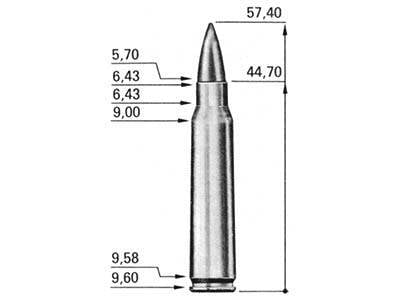 Drawing 5,56-mm rifle cartridge M 193 / .223 Remington
Drawing 5,56-mm rifle cartridge M 193 / .223 RemingtonIn accordance with the new concept, the US military gave priority to the development of promising samples under the SALVO program (volley), in which it was planned to create small arms for a multi-cartridge cartridge. Work on the SALVO program was carried out in the USA in 1953 – 1957. Based on these findings, the US Department of Defense subsequently begins working on a new, improved SPIW (Special Purpose Infantry Weapon) program, under which it was planned to develop promising small arms that shoot small-caliber high-speed arrow-shaped slaughter elements and 30 – 40-mm rifle grenades.
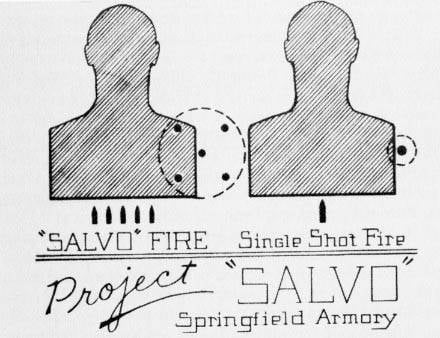 An advertisement brochure of Springfield Armory, illustrating the possibility of hitting a target with the multipulse cartridge of the SALVO project (left) and the classic cartridge cartridge with one bullet
An advertisement brochure of Springfield Armory, illustrating the possibility of hitting a target with the multipulse cartridge of the SALVO project (left) and the classic cartridge cartridge with one bulletIn 1957, the well-known American armory company Winchester was one of the first to start creating a new 224 light automatic rifle, originally the E 1 model, and then the E 2 model, as well as modernized low-impulse cartridges. 222 Remington 5,56-mm E 1 cartridge, developed by the company on the basis of the cartridge. The 43 mm cartridge case length was filled with an ogival shape 3,43 gram with an initial speed of 1006 m / s, but developed pressure higher than the customer’s requirements. In 1958, a second sample of the chuck E 2 appears with an increased sleeve length up to 45 mm, which allows the use of a new brand of powder, which develops less pressure. In this case, the cartridge E 2 had a total length equal to the cartridge E 1, which was ensured by both the sleeve length increased by 2 mm and the depth of the bullet.
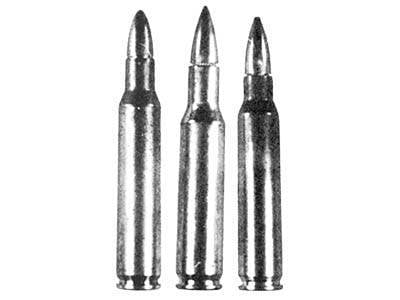 222 Remington rifle cartridges (left to right): 5,56x47 Remington Magnum; 5,56x43 Remington; 5,56x45 Remington Special
222 Remington rifle cartridges (left to right): 5,56x47 Remington Magnum; 5,56x43 Remington; 5,56x45 Remington SpecialA small American arms firm Armalite Div. Inc went a different way. The basis for the development of the first part of its “ammunition-weapon” complex was also served by the low-impulse sports patron already occupied its niche in the US arms market in the US. 222 Remington. A few years ago (in 1952 – 1953), the self-loading 2 M carbine, re-blended to a low-pulse cartridge, was tested in the United States. The 222 Remington (5,56-mm) with an oval-shaped lead core bullet designed by Sierra Bullet Co. In this carbine, by reducing the caliber and mass of the bullet of a new cartridge, American gunsmiths managed to achieve a sharp increase in the initial speed with a simultaneous decrease in the recoil momentum. Therefore, the use of the patron. 222 Remington, which by that time managed to show itself from a good side, created the foundation for the further work of the young engineers of the company Armalite, Robert Fremont and James Sullivan. In the 1957 year, they remade the rather successful 7,62 x51 design of the Armalite AR 10 automatic rifle, created three years earlier by another young and talented designer Eugene Stoner. However, during the very first tests it turned out that the power of the powder charge used in the cartridge.222 Remington is not enough to meet the requirements of the US Army for penetration and the initial velocity of the bullet. Therefore, in the same year the firm Armalite Div. Inc., with might and main to develop a new rifle Armalite AR 15, had to enter into an agreement with the largest American arms company Remington Arms to develop and manufacture a modernized version of the cartridge. The new model of the cartridge received the designation ".222 Remington Special". In order to bring the TTX patron.222 Remington Special in line with the requirements of the command of the continental army (U. S. Continental Army Command), a number of changes were made to its design. The cartridge case was also taken as the basis for creating the new cartridge. The 222 Remington, but extended to 44,7 mm, which allowed the cartridge to be equipped with an increased charge of spherical powder of a new brand. Thanks to this, it was possible to reduce the pressure when fired from 379,2 MPa to the allowable army requirements of 358,5 MPa with a minimum decrease in the initial velocity of the bullet from 1012 m / s to 990,6 m / s. The new cartridge received a shell bullet with a lead core of 3,56 gram mass.
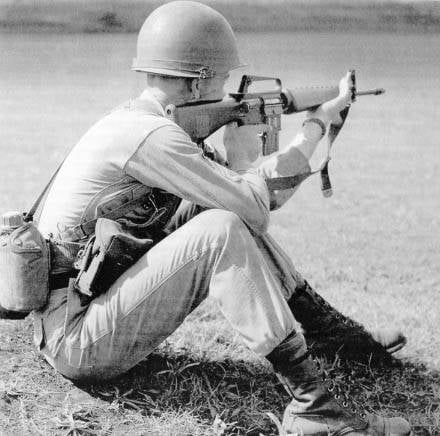 Tests of the 5,56-mm AR 15 assault rifle in the US Army. Beginning of 1960's
Tests of the 5,56-mm AR 15 assault rifle in the US Army. Beginning of 1960'sAt the same time, Remington, under a contract with the arms firm Springfield Armory, mastered the production of another military 5,56-mm low-impulse cartridge designed by Earl Harvey, which received the designation ".224 Springfield". This ammunition was also intended for a promising light automatic rifle. But since he did not meet the requirements of the US Army, in 1958, Remington was forced to retrain it as a cartridge for sport shooting and continued production, but under a different name - “.222 Remington Magnum”. In the 1959 year, in order to avoid confusion with the names of the ammunition caliber. 222, the company Remington renames the cartridge ".222 Remington Special" - in the cartridge ".223 Remington".
In 1957 – 1959, several samples of automatic rifles for cartridges were developed by order of the US military. 223 Remington. In 1958, the first rifles of the company Armalite AR 15 were transferred to the US armed forces for field testing. During the tests, a number of problems emerged with the reliability of the operation of these weapons and the accuracy of firing from them.
Still, the AR 15 rifle, after a series of failures and defeats, in the course of a tough, not to say cruel, struggle managed to achieve a convincing enough victory over its rivals: automatic rifles M 14 and G 3, calculated under the patron of NATO 7,62 x X51; and new samples: .224 light rifle Winchester, as well as .223 (5,56-mm) automatic assault rifles designed by Eugene Stoner - AR 18 and Stoner XM 22. In addition, the issue was unequivocally resolved with the choice of a new cartridge. In the course of conducting competitive tests when shooting an AR 15, an E 2 caliber cartridge. 224 from Winchester gave way to a cartridge. 223 Remington (5,56 x XXUMX), which was the most successful and was recommended for adoption by the American army with an AR 45 rifle. However, the designers of Winchester still continued their work in this direction, and in the 15 year for the AR 1959 a new 15-mm cartridge E of the 5,56 appeared with a sleeve that had a much larger volume. The flange (rim) of this sleeve was equal in diameter to the cartridge case. 5 Remington, which made it possible to adapt the AR 223 rifle to a more powerful cartridge with minor changes in the design of the weapon itself.
The first positive test results of the 5,56-mm light automatic rifles contributed to the fact that already in the same 1959 year, the American weapons company Colt bought the right to manufacture the AR 15 rifle from Armalite and began its release as a commercial sample, planning to sell to Malaysia and India . In December of the same year, the first production model of this weapon, known as the “AR 15 Model 01 Colt Model 601”, was born. And at the beginning of the next, 1960, this model was handed over to the US military to continue to participate in the competition to create a light automatic rifle with a high initial speed (LWHVR).
In the same year, the 1960 company Colt demonstrated the AR 15 rifles to the Deputy Chief of Staff of the United States Air Force, General Curtis LeMay. Field tests of this weapon once again showed the high efficiency of units equipped with rifles for a new cartridge. Impressed by the demonstration firing, LeMay expressed his desire to purchase AR 15 assault rifles for the security services of the US AF Strategic Air Command security forces. They planned to replace both the outdated 7,62-mm automatic rifles M 2 and the new NATO 7,62-mm automatic rifles M 14, as well as 11,43-mm submachine guns M 3. This was due to the fact that the 5,56-mm AR 15 rifle compared with the 7,62-mm M 14 rifle had smaller dimensions and weight, higher rate of fire and better accuracy of the battle when shooting bursts. When fired at a range of 270 m, it exceeded 14 X in accuracy by 1,2 times, while spending less than cartridges in 1,5 times. A significant reduction in the mass of the AR 15 rifle and its ammunition made it possible to significantly increase the wearable load. With a total equal mass of weapons with an 7,5 ammunition, the soldiers could carry, in addition to the AR 15 rifle, 250 cartridges of the 5,56 caliber mm to her, while with the 14 M rifle he could carry only 100 mm cartridges with him. The 7,62 mm 660 caliber cartridges equipped in thirty-three 5,56-charging stores for the AR 20 rifle weighed as much as the 15 280-mm ammunition cartridges in fourteen 7,62-charging magazines for the 20 M rifle. This significantly increased the firepower of the units. Therefore, in 14, for the final decision, the command of the US Armed Forces found it advisable to purchase automatic AR 1961 assault rifles for the next year with the purpose of their trial operation in the combat situation in Vietnam by US Airborne Troops. After a series of tests and improvements made, the new rifle and cartridge for it in 8500 were adopted by the US Air Force under the official designation “XM 15” and “Cartridge 1963 mm Ball M 16” (cartridge 5,56 mm with M 193 bullet), respectively.
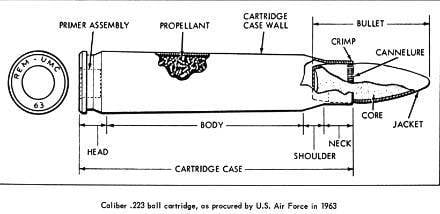 Drawing 5,56X45 rifle cartridge M 193, adopted by the US Air Force in 1963 year
Drawing 5,56X45 rifle cartridge M 193, adopted by the US Air Force in 1963 yearThe 5,56-mm rifle cartridge M 193 was fixed when sending into the chamber by means of the sleeve into the cone of the chamber. The cartridge consists of a bullet, cartridge case, primer-igniter. The bullet with an ogival head and a back cone consisted of a steel clad tampacom shell and a lead core. In the middle part of the bullet, an annular knurling was performed, into which the cartridge liner was crimped when the cartridge was assembled. The edges of the shell in the tail section of the bullet were rolled up with support on the bottom of the core. The bullet was not stained. Cartridge sleeve brass bottle-shaped with groove and non-protruding flange (flange). For a more reliable connection, the bullet is fixed in the sleeve with a segment crimp of the edge of the sleeve. The bullet at the liner of the liner had an external sealing with red lacquer.
Supporting the development of the 5,56-mm small arms complex, the US Army actually returned to the two-cartridge system of weapons, but on a new basis - on the basis of a low-pulse 5,56-mm cartridge for an automatic rifle with significantly less than the rifle-and-machine-gun cartridges (7,62 x X63.30 – 06 Springfield and 7,62 NATO), the recoil momentum - 0,58 instead of 0,78 and 1,19, respectively. By reducing the caliber and mass of the bullet, American specialists succeeded, despite the increase in its initial velocity to 960 m / s, to sharply reduce the recoil momentum of the cartridge. And since the recoil energy of the weapon is directly proportional to the square of the recoil impulse, this has significantly reduced the dispersion of shots during automatic firing from unstable positions. Combined with good trajectory flatness, this provided the advantage of the M 16 rifle in firing performance compared to the M 14 rifle. In addition, the designers of the 5,56-mm cartridge M 193 managed to solve the problem of increased slaughter effect of small-caliber light (3,56 g mass) bullets. The undoubted merit of American designers ammunition is the competent use of this effect, which made it possible to make a qualitatively new step in the development of small arms towards reducing its caliber.
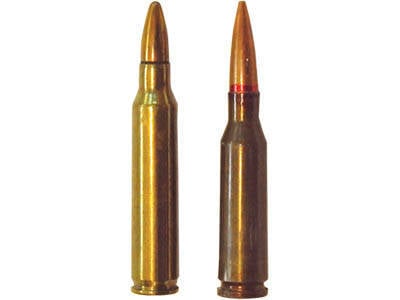 5,56х45 American-made rifle cartridge М 193 (left), 5,45х39 Soviet-made 7Н6 automatic cartridge (right)
5,56х45 American-made rifle cartridge М 193 (left), 5,45х39 Soviet-made 7Н6 automatic cartridge (right)Wounds from small-caliber bullets differed more extensive outlets, crushing bones; frequent cases of destruction of bullets in the human body with the formation of fragments; overturning bullets and their tumbling in the tissues of the body, aggravating the severity of the injury. In a rifle, the stabilization of a bullet flight is achieved by rotating it around its axis at a speed that gives the bullet properties of the gyroscope — that is, they are resistant to tipping over. In the 16 M rifle, both their design and the design of the weapon itself contributed to the tilting of small-caliber bullets. Like all oblong shells, the center of gravity of the 193 M bullets was located closer to their bottom part, and the center of resistance to movement was near the head part. When meeting a barrier, a pair of forces acted on the bullet - the force of gravity applied to the center of gravity and the force of resistance to the movement of the bullet applied at a point closer to the head part. Under the influence of this pair of forces, an overturning moment was formed. If its magnitude exceeded the gyroscopic stability of the revolving bullet of the ogival shape, then it overturned, and since the movement of the bullet continued, then, tumbling, it inflicted heavy wounds.
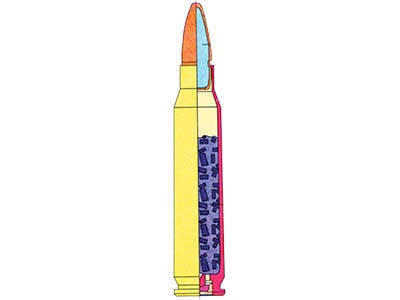 Cut 5,56x45 rifle cartridge 193 M
Cut 5,56x45 rifle cartridge 193 MIt is this feature of the 5,56-mm cartridge M 193, fully revealed its negative side. The emergence of a new American patron has caused something in the world that looks like a sensation. Moreover, the responses from the battlefields of these weapons and the cartridges to it were very eloquent. So, on June 16, 1962, three American Rangers from the 340 Company entered into a shootout with Vietnamese soldiers. Two of them were armed with 7,62-mm self-loading rifles M 14, and one - 5,56-mm assault automatic XM 16 rifle. In the melee, from fifteen meters, the ranger, firing continuous fire from this rifle, destroyed three enemy soldiers. Vietnamese were fatally wounded: one - in the head, the second - the arm and the third - in the right side of the chest. And each of these wounds was about five inches in diameter (12,5 cm) and was fatal. Another American veteran of the Vietnam War, Sergeant John Blake, said: “My combat experience, the whole infantry instinct, rebelled against small caliber. But in the same skirmish with the enemy, I burst out on my thigh and hit the Vietnamese in the shoulder. The lieutenant warned me that the 5,56-mm bullet was highly effective, but what I saw exceeded all my expectations. The bullet that hit the enemy in the shoulder threw him back and broke his arm so that he died of shock. ”
Therefore, in the middle of the 1960s, after several years of intense fighting by the Americans in Vietnam, the international community seriously considered the issue of banning the new 5,56-mm small-caliber cartridge for the American XM 16 rifles. Numerous colorful stories have arisen about how a bullet “tumbles in flight”, as a result of which, hitting a target, it inflicts terrible wounds, although no one has tried to explain how a bullet manages to hit the target if it tumbles in flight. It was believed that the use of the 5,56-mm 193 M cartridges for the XM 16 rifle by the US Army during the Vietnam War revealed that bullets inflict significantly more serious wounds than traditional 7,62-mm caliber bullets. Allegedly small-caliber bullets weighing just 3,56 g lead to injuries that are comparable in severity to the actions of semi-shell explosive bullets of the dum-dum type prohibited by the Geneva Convention. This was the basis for comparing wounds from XM 16 rifle bullets with the striking effect of explosive ordnance, therefore doubts were expressed as to the legitimacy of using small-caliber cartridges in general and the X-MX cartridge in particular.
Since the shell of the 5,56-mm bullet did not have cuts that contributed to the destruction of the fragments and aggravating the severity of the injury, the cartridge X 193 M did not fall under the prohibition of the Geneva Convention. However, in its aerodynamics, the bullet of the M 193 cartridge had a rather obtuse form, similar to the cartridge. 223 Remington. Of course, this cannot be attributed to the ignorance of American specialists of the role of the ballistic advantages of bullets of good aerodynamic shape. An example of this is the NATO 7,62-mm rifle bullet (T 65) and one of the best 7,62-mm American rifle bullet M 2 for the rifle and machine-gun cartridge. 30 – 06 Springfield mod. 1926 of the year, which had a form factor of 0,42. Most likely, the idea of ensuring the maximum possible slaughter effect of a 193 mm caliber bullet dominated the creators of the patron M 5,56, because of which its shape with a small radius of the head part was preserved. In the case of 5,56-mm bullets, it was empirically proved that overturning when meeting an obstacle occurred more often when firing small-caliber weapons than when firing from traditional-caliber weapons - 7,62-mm. Therefore, the American designers were taking a certain risk by offering to re-equip the cartridge caliber 5,56 mm instead of 7,62-mm NATO cartridge, trying to minimize the claims to its destructive action.
Nevertheless, in order to find out why new ammunition inflicted such severe injuries, large-scale research was conducted in the United States, as a result of which specialists were able to identify potential directions for further improving combat small-caliber weapons. It was found that the nature of the injuries depends not only on the device of small-caliber bullets, but also largely on the design of the weapon itself, in which they are used. When examining the injuries inflicted by 193 M bullets, American surgeons in Vietnam succeeded in proving that the bullets, as a rule, following a straight trajectory, passed in dense tissues a distance of about 12 cm head forward, and then turned around 90 degrees, collapsed and broke off in the middle part in the area of the annular knurling. The head of the bullet at the same time was about 60% of its initial mass. The tail of the bullet decayed into many fragments, which scattered to the sides and penetrated into the tissue to a depth of 7, see. When it fell into soft tissues, a strong effect of the temporary cavity appeared. Along with this, there was also a significant rupture of tissues, due to the fact that at first they were broken through by splinters and then exposed to the action of the temporary cavity. Therefore, openings in hollow organs, such as guts, could reach diameters up to 7 cm. However, for all that, the amount of slaughter effect of 5,56-mm bullets was still significantly less than that of 7,62-mm bullets of rifle cartridges at the same shooting range.
After four years of active combat use of these weapons, 28 February 1967 of the year, the US forces (Army, Air Force, and Marine Corps) unilaterally, without agreement with NATO allies, put into service the 5,56 and 193- mm 5,56 A16 M assault rifle as a standard sample to replace the standard 1-mm self-loading M 7,62 rifle. To eliminate the shortcomings of the 14 A16 M rifle over the years, American gunsmiths had to increase the slope of the rifling of its barrel: the rifling pitch was reduced from 1 mm to 356 mm, the bullet received a rotation of 305 revolutions per second, which ensured the stabilization of its flight without tipping the air. Improvement of small-caliber weapons was carried out by American designers on the basis of conclusions about the laws of action on the projectile of gravity and the resistance of the medium to the movement of the bullet, as well as by changing its design. The transition of small arms from the caliber 3246 mm to the caliber 7,62 mm has significantly improved the efficiency of the American small arms system.
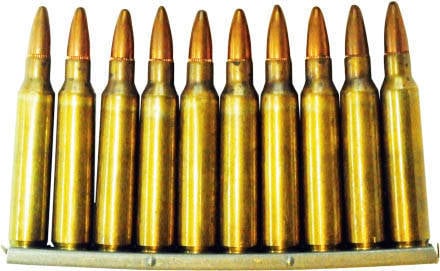 10 charge holder with 5,56 mm rifle cartridges M 193 for assault rifle M 16
10 charge holder with 5,56 mm rifle cartridges M 193 for assault rifle M 16Following the USA, small-caliber automatic rifles and light machine guns were adopted in many countries. In the Soviet Union, as a worthy response to the American challenge, its own small-caliber 5,45 x39 cartridge of the 1974 model of the year and a whole range of small arms samples for it were developed. The striking effect of small-caliber bullets was found not to contradict the norms of the International Agreements on the Use of Small Arms.
Information